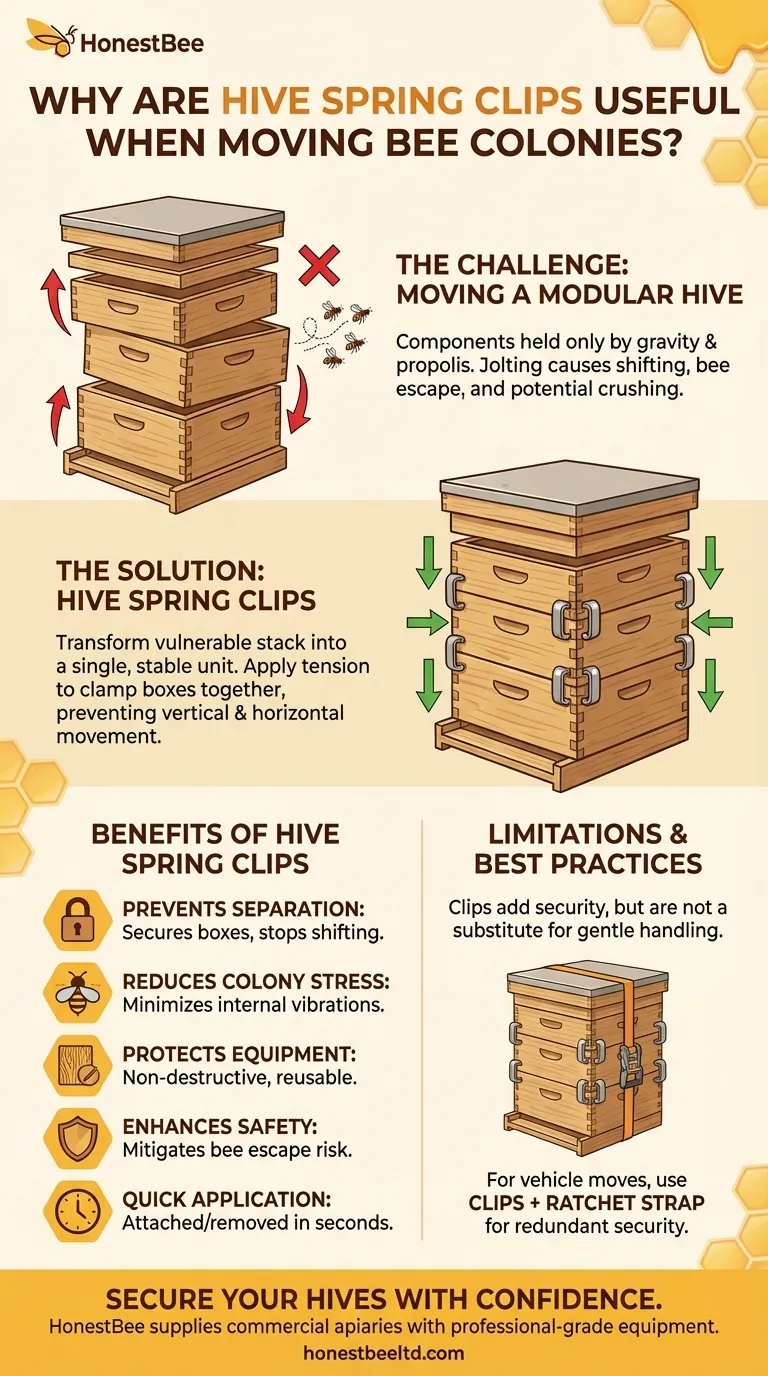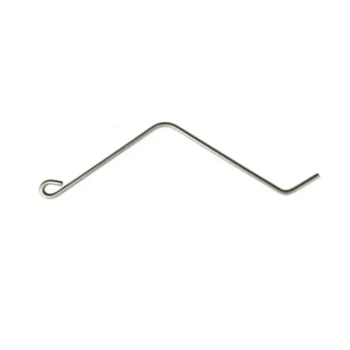When moving a bee colony, Hive Spring Clips are simple but critical tools used to fasten the individual boxes of a beehive together. Their purpose is to prevent the hive components—the bottom board, brood boxes, and supers—from shifting, slipping, or separating during the inherently jarring process of transport.
The core value of a hive spring clip is transforming a vulnerable stack of wooden boxes into a single, stable unit. This integrity is the foundation for ensuring the safety of the colony, the beekeeper, and anyone nearby during a move.

Why Hive Integrity is Paramount During a Move
To appreciate the role of spring clips, you must first understand the risks involved in moving a modular hive.
The Modular Nature of a Beehive
A modern beehive is not a single box. It is a stack of components: a bottom board, one or more deep boxes for brood, shallower boxes (supers) for honey, an inner cover, and an outer cover.
These components simply rest on top of one another, held together primarily by gravity and the bees' own propolis seals.
The Dangers of Shifting Components
During transport, any bump or sharp turn can cause these boxes to slide apart. Even a gap of a few millimeters is enough for thousands of agitated bees to escape.
A significant shift can lead to catastrophic failure, potentially crushing bees and even the queen between boxes, toppling the stack, and releasing an entire defensive colony.
Minimizing Colony Stress
Movement is inherently stressful for a bee colony. A secure, stable hive minimizes the internal vibrations and disturbances.
Keeping the hive intact ensures the cluster of bees remains calm and the internal structure of the comb is not damaged by excessive jolting.
How Hive Spring Clips Address the Challenge
Hive Spring Clips are a direct and effective solution to the problem of hive component separation.
Simple Mechanical Security
These are sturdy, C-shaped metal clips designed to create tension. One end hooks under the handhold or bottom edge of a lower box, and the other end presses firmly down on the top edge of the box above it.
This tension effectively clamps the two boxes together, preventing both vertical and horizontal movement at the point of connection.
A Rapid and Reusable Method
Unlike screws, which damage the hive bodies, or cumbersome straps, which can be slow to apply, spring clips can be attached or removed in seconds.
Typically, two to four clips are sufficient to secure a standard two-box hive, making them a highly efficient tool for beekeepers.
Understanding the Limitations and Alternatives
While incredibly useful, spring clips are part of a broader strategy for safe hive transportation.
Clips Are Not a Substitute for Care
Hive clips add security, but they do not make a hive indestructible. You must still handle the hive smoothly and gently, avoiding any sudden drops or tilting.
Comparing Clips to Ratchet Straps
Ratchet straps are another common method for securing hives. A strap cinches the entire stack together from top to bottom, offering excellent security, especially for long-distance moves over rough terrain.
Many beekeepers use both: spring clips to prevent individual boxes from twisting or shifting, and a ratchet strap as the primary fastener for overall stability.
Making the Right Choice for Your Move
Your securing method should match the specific demands of the relocation.
- If your primary focus is a short move across the yard: Hive spring clips provide the fastest and most efficient way to ensure the hive remains intact.
- If your primary focus is moving a hive by vehicle: Using both spring clips and a ratchet strap offers redundant security for maximum safety and peace of mind.
- If your primary focus is on long-term equipment care: Spring clips are far superior to nails or screws, which cause permanent damage to your woodenware over time.
By properly securing your hive, you turn a potentially chaotic event into a controlled and safe procedure for your colony.
Summary Table:
| Key Benefit | Description |
|---|---|
| Prevents Separation | Secures hive boxes together to stop them from shifting or sliding apart during transport. |
| Reduces Colony Stress | Minimizes internal vibrations and disturbances, keeping the bee cluster calm. |
| Protects Equipment | A non-destructive, reusable alternative to screws or nails that can damage woodenware. |
| Enhances Safety | Mitigates the risk of bee escape and catastrophic hive failure, protecting the beekeeper and colony. |
| Quick Application | Can be attached or removed in seconds, offering a fast and efficient securing method. |
Secure Your Hives with Confidence
Moving colonies is a high-stakes operation. The right equipment is not just a convenience—it's a necessity for protecting your investment and ensuring the safety of your bees and your team.
HONESTBEE supplies commercial apiaries and beekeeping equipment distributors with the durable, reliable tools needed for successful operations. Our wholesale-focused model means you get the professional-grade equipment your business depends on, from Hive Spring Clips to comprehensive hive moving kits.
Let us help you equip your operation for success. Contact our team today to discuss your wholesale supply needs and discover how our products can bring stability and safety to your beekeeping practice.
Visual Guide

Related Products
- Versatile Ratchet Hive Strap with S-Hooks for Secure Fastening
- V-Shaped Spring Hive Connector for Beekeeping
- Heavy Duty Ratchet Hive Strap
- Heavy-Duty Galvanized Steel W-Style Pallet Clip
- Professional Galvanized Hive Strap with Secure Locking Buckle for Beekeeping
People Also Ask
- What are the basic components of beekeeping equipment? Build a Thriving Hive from the Start
- What should be done after placing the hive in its new location? Ensure a Smooth Transition for Your Colony
- How should you secure the bees before moving them? A Guide to Safe, Stress-Free Hive Transport
- How do you loosen a ratchet strap? Master the 180-Degree Release for Easy Unloading
- Why should a tie-down strap be used to secure a hive? Protect Your Colony from Tipping and Damage



















